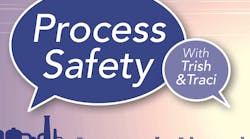In this episode, Trish and Traci speak with podcast guest Valerie Stakes, a bilingual safety trainer based in San Diego, California.
Transcript
Traci: Welcome to this edition of "Process Safety with Trish & Traci," the podcast that aims to share insights from current incidents to help avoid future events. I'm Traci Purdum, Senior Digital Editor with Chemical Processing. And as always, I'm joined by Trish Kerin, the director of the IChemE Safety Centre.
No worries! Subscribe and listen whenever, wherever.
Hi, Trish. How are you doing?
Trish: I'm doing well, Traci. How are you doing today?
Traci: I'm doing all right. I'm watching the hurricane down there, Hurricane Laura down on the Gulf Coast, and going into Louisiana and Texas. So I've been making sure we're okay down there. But other than that, it's pretty much status quo here.
Trish: Yeah. I've been very closely watching that as well. It was just some of the pictures and images I saw last night my time were just horrifying and the intensity that was certainly going through, Lake Charles and I see that is certainly at least one process-safety related natural hazard incident occurring down there at the moment with a substantial fire by the look of it.
Hopefully everybody's okay down there. I couldn't imagine what it would be like, and certainly, my thoughts go out to everybody impacted by Laura. It certainly was an incredibly intense hurricane that hit that very important region of the U.S.
Traci: And I'm hoping... I know they've been talking about this for some time, so I'm hoping that everybody was... I know that process plant that is on fire. They did say that everyone was evacuated prior to the hurricane coming landfall so, hopefully, everybody's okay down there. (See: Fire At Louisiana Chemical Plant Sends Chlorine Gas Into Air).
Val is a bilingual safety trainer based in San Diego, California. You can email her at [email protected].
Switching gears a little bit, though, today's topic tackles the importance of safety literacy. How do you ensure your workforce understands your safety protocols? And joining us today for that very topic is Valerie Stakes, a longtime bilingual safety professional, and corporate trainer who has worked in the aviation, construction, manufacturing, and insurance industries, and served as an instructor for the OSHA Training Institute at UC San Diego. She's based in San Diego, California. Thanks for joining us today, Val.
Valerie: Hey, thank you both for having me.
Traci: Well, I know that you're celebrating 15 years in the industry and I want to know what brought you to the exact space of being a trainer, a bilingual trainer?
Valerie: Well, the time certainly has flown during these past 15 years. I spent about three years investigating how I could go into corporate training and teaching, and always had a passion for using my second language, which is Spanish. I grew up in the Salinas Valley and had used that language pretty much in every job I've had since I was 15 years old. I had some very wise people in the construction industry who suggested that I look into safety training. And the more research I did, the more that I found that the need existed and also and very sadly in terms of the statistics, we were seeing a much higher rate of incidents, injuries, and also fatalities in the Spanish-speaking workforce. So this became more than just an opportunity, it became more than a vocation. It was something that I needed to go do.
Traci: Well, I know your passion and Trish's passion today is going to shine through on this podcast so I'm looking forward to hearing what you both have to say about this. And Trish, you and I were discussing the importance of safety literacy, and you mentioned that the IChemE Safety Centre has been translating documents and webinars into Spanish. Can you give us some insight why that's important?
Trish: Yeah, sure. When we're talking about safety, it's so important that the messages we're trying to communicate are understood by the audience we're sharing them with. And so if we don't speak the language that they understand best, they're not going to get the understanding of the communication that we need to share, and that's going to lead to safety incidents. It's as simple as that. If people cannot understand the material that they need to understand because of a language barrier, there will be safety incidents. We need to make sure that we can have our materials translated so that people can access them. They can understand what's going on, they can get that learning, they can get the information.
In Australia, for example, it is actually a legal requirement that safety information is provided in the language of the workforce. Now, the language of Australia is English. However, the large migrant population, we have an enormous number of multilingual people in our country, which is fantastic because it really enriches our country. And they speak English as a second language, sometimes a third, fourth, or even fifth language, though. So we need to make sure in the English-speaking world that we actually accept our material. If it's important information, it has to be available in other languages for people. Otherwise, they're not getting our message. We can't expect them to understand our message in detail when their safety or the safety of their colleagues relies on it. We can't make that assumption. We have to give them the information in the best way that suits them. And in some instances as well, it's not only a language translation that's required, we also do need to take into account literacy needs as well. So how material is provided to people to make sure they can understand, whether it's in a language, a literacy, or whether it's of the appropriate numeracy requirements for them too.
Valerie: And Trish, I can piggyback on that as far as the Occupational Safety and Health Administration, you know, detailing those requirements and they have their communication standard, which has everything to do with hazardous materials and chemicals. It states that the employer must provide training in a language and in a meaning that can be understood. So your point on literacy is spot on. You could translate everything and present the materials and hand someone a toolbox talk, or training materials, it isn't necessarily enough. How do we know that what we've just presented has even been understood?
Trish: Absolutely.
Traci: Val what are some of the challenges that companies may not realize that they face if they only present information in one language? And as you both have talked about the literacy, making sure that it's comprehended, what are the challenges that you've seen out there?
Valerie: Well, I think, again, piggybacking off of what Trish mentioned, it would be really simple if it was just bilingual, if it was just Spanish-speaking, but we're facing a very multilingual workforce. So how do you tackle that in a means of, well, gosh, what if I have 10 different languages that are being spoken? I think really knowing your workforce and that's the makeup of it linguistically, culturally, and finding that out, get to know your audience. And then what I have done in different situations, where I haven't spoken every language, is relying on some of the safety leads within -- kind of recruiting people within the company who can help me and ensuring that everything is being understood.
Traci: And you bring up a good point, relying on the strong leaders within the workforce to help get that message across. Trish, we were talking about the fact that it’s not just simply translating documents, that's just not good enough, what are some of the other things to consider? I know you mentioned the numeracy and other things, but are there things that companies really need to sit down and realize that they have some hazard points there?
Trish: Well, there certainly is. One of the experiences I had for the first time, actually, last year was I delivered a presentation to a group of Chinese visitors. And so I had to work with a translator for my presentation. Now I didn't need to have the words translated on the slides, but everything I spoke was translated. And so it's not just a matter of assuming that they're just going to be talking in the sidelines and they'll be telling the people what I'm saying, I had to speak in a different way. I had to provide small snapshots of information to people so that it was something I could then pause for them and the translator would translate. And one of the things that struck me at one point was I said something and he looked at me and said, "We didn't have a word for that in Mandarin. I can't translate that." And I thought, "Oh, okay." So I had to explain what I meant even further because language is not just a copy of the same words in different languages, and grammar doesn't work that way either. So, you know, how we actually word things can be really important for its ability to be translated. We have our documents translated as well because it's not just the straight translation.
One of the other things I learned recently as well when I was watching some sign language signers translating for some of our politicians, again, they're not saying the exact words that the politicians are saying just in a different language with their hands, they're actually translating the intent of the message. And so you need to make sure that you understand the intent of the message that's being translated. And in fact, it can be quite amazing to watch the sign language translators because they not only use their hands, but they use their faces as well in the expressions to translate the intent of the message, which I think it's absolutely beautiful to watch. I wish I could understand it. I'm actually thinking of trying to learn the Australian sign language because I find it such a fascinating topic.
But when we have our safety law documents, for example, translated, they are translated by a volunteer in South America who wants to see our material in Spanish, which is fantastic for us as well. We then receive that translation back and I then send it to another multilingual engineer for them to check the translation because I can't check it. I don't know whether it's a good translation, has it made the intent of what we're trying to say? Now, note, I don't just send it to a Spanish speaker, I actually send it to a Spanish-speaking engineer in the field...
Valerie: That's perfect.
Trish: ...because, yeah, because you've got to understand the nuances of what you're talking about. Technical translation is very different to just conversational translation as well. And you've got to make sure that you get that material right. All of our safety law documents are translated into a Spanish written version. And Traci, you mentioned our webinars. This same organization in South America came to me recently after I gave a webinar on leadership and safety during the COVID pandemic or during uncertain situations and requested if they could translate that webinar as well. And so, again, we went through that same process. They translated it, we sent it to our Spanish-speaking, English-speaking chemical engineer. She vetted the translation for us, and we were then able to release it.
I have to say I don't speak Spanish and it was really quite strange to watch my slides partly in English and partly in Spanish because depending on the nuances of the translation so that my slides were translated into written Spanish as well. And then listening to this other person talking about my material in a language I couldn't understand was really quite a strange experience for me. I was just happy that I picked a woman, at least. It was a female talking to me. I thought, "At least... That's cool, I like that." And, you know, her voice is... I've often been told I have a calming, easy to understand accent in my language. So, you know, I got that sense from the woman that did the actual verbal translation as well.
Valerie: So Trish, I come from a translation and interpreting background. That actually was my master's degree at Kent State in Ohio. And one of the first things we learned is exactly what you're referring to as far as having the business sense thrown in there, the technical, it isn't enough just to go work the work. And Traci, you and I talked a little bit about throwing things into Google translation and using something that will just put in words and it just spits it out on the other end. And what you end up is sometimes with...is a big mess and things that are completely wrong in terms of syntax and grammar and, like, what the heck even is this?
I've learned so much throughout the years, especially when I've taught certain subjects repeatedly, picking up different vocabulary, and often asking my audience, "Hey, how do you...you know, what's the right word for this particular tool?" And it's interesting, often they grab the word in English. They've been here long enough, like, "Yeah, we don't know what that is. We call it scaffolding," and I'm referring to scaffolding. And, like, "No, we just call it scaffolding." So it's interesting what you can learn and kind of pick up. But my advice would be is to do exactly, Trish, what you're doing, having it professionally translated. Having someone take a look at it who is in that field. And even if you can have someone within your workforce who is fairly sharp in both languages and have them give it a good proof and say, "Will this work?"
Trish: I find it really interesting that we do see the adaption of English words into multiple different languages now as it's evolved over time. I mean, likewise, in the English language, we use words from other languages as well that have used adapted over time and we never bothered to have an English version, we just accept the other language version, but it's always interesting that when you do hear someone speaking and then all of a sudden you hear a word you understand more clearly with the English. I do find that fascinating that, especially in some of those technical areas, that we have ended up in the situation of that word is just the word we're going to use, and it's generally accepted, though, it's never defined that way. You said the Spanish word for what scaffolding would be, but no, actually we just call it scaffolding.
Valerie: Sometimes I don't have the luxury of giving the lecture in one language or the other, I have to simultaneously translate or interpret myself. And there have been moments where I've forgotten which language I've spoken. And it's pretty hilarious because all of a sudden I stop speaking English. And this has happened at least like half a dozen times where it's like, "Time out, you're still speaking Spanish," and, "Oh, I'm sorry." It's like, yeah, the brain is an interesting thing.
Trish: Wow. I mean, awe of your ability there.
Traci: Yeah. I don't know how you do it either. It's amazing, and, Trish, you were talking about the sign language. I did take sign language in college and just watching the fervor that they go through to make sure that everybody understands, just from their body expressions and their facial expressions is the whole package and it's just something that is...it's an art form, definitely.
Now, Val, what goes into creating an effective safety program for other languages and learning needs? Are there basics that companies can start with and go forward with to make sure that they are as safe as they can be?
Valerie: Yeah. I think ensuring that you're on top of having an effective evolving safety program in any language. So, in any given industry, it's dynamic, things change, things you add, maybe there's operations that you no longer have. So ensuring that your safety program is current and that the training follows. As you have workforce come in and just having that cognizance of knowing who's there and who needs what. I think that would probably be the best in any language.
Traci: Is there a place they can come... Like, do you get a call? Are you part of a phonebook that people can call and know that you're a safety trainer, and is that something that other people can use?
Valerie: On some days, yeah, I get a lot of those requests. I am developing something right now for an agricultural group and they already have an amazing safety program, and they want to take it a little bit further, I'm working on some safety leadership training for them right now. So it's something they have the basics already, and then it's a matter of researching, you look at what's available. There are far more materials available than when I started 15 years ago. I used to have to write everything myself. Now, OSHA, Cal/OSHA both have some great training materials out there [you can access them here]. A lot of organizations have things bilingual. So starting there and not having to reinvent the wheel. And then you can always customize from there.
Traci: Trish, does Australia have that same sort of well to pull from?
Trish: No, I don't believe we actually do, which is certainly a challenge. I think we, at the moment, still have just in either companies, it's around taking the resources you need to do your translation of your materials that you need, and from the government perspective as well. They work with the migrant communities to work through and understand some of that translation. I don't believe that there is actually a pool of material that's available here. It's interesting, I'm not sure whether that is because there's a number of different languages that we're looking at versus I don't know what the situation is within the U.S. I mean, obviously, Spanish is a significant language spoken in the U.S. and I would presume that there's several others as well that are now starting to become a lot more prominent. But certainly, we've got such a wide range of languages spoken in Australia that when community service information is put out, for example, it can be out in, you know, 15 to 20 different languages over here.
Valerie: And I know there's a lot of grants. There's something called the Susan Harwood Grants that are through OSHA, and that has helped a lot of organizations, a lot of nonprofits translate their materials into a variety of languages.
Traci: Good. It seems like there are some resources. And in the transcript of this podcast, I will link to those things that you've talked about. But Val, you and I were talking, and I want you to tell a little bit about how it is to perform these safety classes and have the students be so appreciative. I think that speaks volumes.
Valerie: Well, I think that, again, it's such an untapped resource. It's just not...it hasn't been provided the way it really should be. And, you know, when I started, I was incredibly surprised that as a non-native speaker and even female going into mostly construction companies in the beginning, just how well received I was. And I had been told that in Hispanic culture that teachers, doctors and nurses, and those in the religious community are the most highly respected. So I was a teacher being brought in and I would often get thank yous. People want to hug me, shake my hand, say, "Thank you so much for doing the training for me. I've never received safety training in my career." That to me is the biggest paycheck right there, is someone saying thank you.
Trish: And you often know that you actually kept them safe as well. So, you know, you provided them with information they needed to know, that's going to mean they go home at the end of the day to their family.
Valerie: I think there is that absolute recognition as far as the importance of it. So I would say those are my best audience. You know, not saying anything about any of the classes I've taught and all the people I've had the opportunity to meet because it wasn't appreciated, but you definitely receive so much positive feedback from the classes that are not necessarily in English.
Traci: Now, Val, Trish knows that I have a favorite question at the end. It's the open-ended one. Is there anything you want to add that you think is important that maybe we didn't touch on?
Valerie: We could talk about this for hours.
Traci: Trish, I know you always have something to add.
Trish: What I'll add is just it's so important that we get communication with our workforce and with our stakeholders right, particularly when it comes to process safety, because it's about their lives and the lives of those around them and the impact on the community. And so we need to take every effort we can to make sure the communications we share are understandable and fit for purpose. And that means we need to be prepared to have them translated, we need to make sure they're at the right literacy standard because there's no second chances on this. Process safety doesn't give you second chances. Process safety incidents are so significant. We've got to stop having them. We've got to get this right. And so I would implore anybody out there to keep the language literacy, numeracy elements of your training programs, your communication, your procedures at the front of mind. You can't just continue to work in one language only, regardless of what that one language is.
Valerie: I thought of something. The question that I have for myself, whenever I lead any type of training is: Was it effective? Did they pick up what I was trying to get across in terms of the training being effective? And I think that knowing your workforce, or for whoever you are helping, if you're doing the work independently, you know, having a variety of training and resources and methods available. We call it our bag of tricks. So if one thing isn't going to necessarily work, have something else available, whether it's videos. I think, demonstration, not just the PowerPoint, demonstrating the skill, and then having your workers demonstrate that they understand. That's how you can verify if the training was understood, if they can demonstrate what you have just tried to teach.
Traci: Well, it is obvious that both of you have a passion for safety and wanting to make sure that, as Trish eloquently put it, people get to go home at the end of their shifts every night. I do appreciate the time that you both put into this today. Unfortunate events happen all over the world, and we will be here to discuss and learn from them. On behalf of Trish and Val, I'm Traci, and this is "Process Safety with Trish & Traci."
Trish: Stay safe.
Check out all the episodes of Process Safety With Trish & Traci.
Want to be the first to know? Subscribe and listen to Process Safety With Trish & Traci on these platforms




